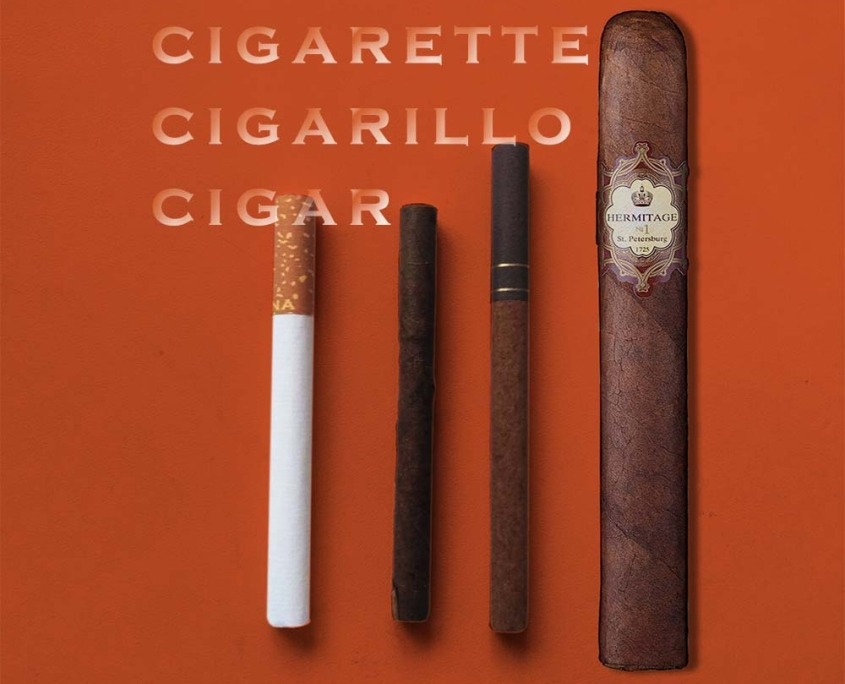6 features to tell the differences between cigars (or cigarillo) and cigarettes

cigar cigarillo cigarette
In this post, I’ll show you EXACTLY how to define cigars and cigarettes.
Even though cigarettes and cigars are tobacco products, there is a huge distance between these two types of tobacco products.
But many people are confused with cigars, cigarettes, cigarillos, or bidis.
So if you want to tell the exact differences between them, keep reading this article.
Feature #1: Appearance

cigar cigarillo cigarette
This is the first thing that catches your eye when you see a cigarette, a cigar, and a cigarillo beside each other.
A cigarette is tobacco leaves wrapped in special cigarette paper, most often white, but there are many exceptions.
Cigarillos or Cigars are cut tobacco wrapped in tobacco leaf or homogenized tobacco (a paper-like sheet made from tobacco leaves).
Cigarillos can be either with or without a filter. But most often, good cigarillos are produced with a special mouthpiece.
There are no additives or filters in traditional cigars.

cigarillos
Feature #2: Size and Shape
Cigars: Cigars are typically larger and come in a variety of shapes, including the classic cylindrical shape. They can range in length from a few inches to over a foot and are usually much thicker than cigarettes.
Cigarettes: Cigarettes are small, cylindrical tubes of tobacco wrapped in paper. They are typically about 85mm in length and 8mm in diameter.
Cigarillos: Cigarillos are smaller and thinner than cigars but larger and thicker than cigarettes. They are often similar in shape to cigars but shorter and narrower.
Feature #3: Composition
- Cigars: Cigars are made from whole tobacco leaves and are rolled into a single, long, tobacco wrapper. The filler tobacco inside can be a blend of different tobacco types, and there are no additives or filters in traditional cigars.
- Cigarettes: Cigarettes are made from finely cut tobacco leaves, which are often blended and processed with additives, such as preservatives, flavorings, and burn accelerants. They also contain a filter at one end to trap some of the smoke and tar.
- Cigarillos: Cigarillos are similar to cigars in that they are made from whole tobacco leaves, but they are often shorter and thinner. Some cigarillos may contain additional flavorings or additives.

cigars making
Feature #4: Smoking Method
- Cigars: Cigars are typically not inhaled deeply. Instead, the smoke is drawn into the mouth and tasted before being exhaled. They are often associated with a slower and more contemplative smoking experience.
- Cigarettes: Cigarettes are designed for inhalation into the lungs. They are typically smoked more quickly than cigars and are often associated with nicotine addiction and a faster, more utilitarian smoking experience.
- Cigarillos: Like cigars, cigarillos are not usually deeply inhaled. They are somewhere in between cigars and cigarettes in terms of the way they are smoked.
Feature #5: Nicotine and Tar Levels
- Cigars: Cigars contain higher levels of nicotine and tar than cigarettes, mainly due to the larger amount of tobacco and the fact that the smoke is not deeply inhaled.
- Cigarettes: Cigarettes contain lower levels of nicotine and tar compared to cigars due to their smaller size and the use of filters, which can trap some of the harmful substances.
- Cigarillos: Cigarillos may have nicotine and tar levels somewhere between those of cigars and cigarettes, depending on the specific product.
Feature #6: Packaging and Availability
- Cigars: Cigars are often sold individually or in small quantities and are commonly associated with premium or hand-rolled products.
- Cigarettes: Cigarettes are typically sold in packs of 20 or more and are widely available in convenience stores and supermarkets.
- Cigarillos: Cigarillos are often sold in small packs or in multiples and are available in a variety of flavors.



 © cigpaper.com
© cigpaper.com
 "Open Bible" by Ryk Neethling is licensed under CC BY 2.0.
"Open Bible" by Ryk Neethling is licensed under CC BY 2.0.




